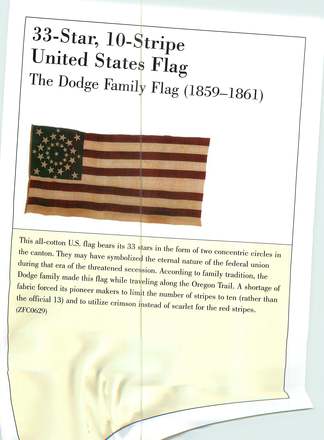33 Star U.S. Flag - Dodge Family Flag from the Oregon Trail.
This period homemade example star United States flag was made to indicate the admission of Oregon as the 33rd state on February 14th 1859; and would remain accurate until the admission of Kansas on January 28th 1861, a period of 1 year, 11 months and 15 days. With this flag being in use for such a short period of time, it would be expected that the 33 star flags would be scarce, however the patriotic fervor prior to the civil war caused a bewildering array of star patterns.
Called the Dodge Flag this 33 star and 10 stripe flag is associated with the Dodge family, who made it either for or during their trek on the Oregon Trail. It appears that they were anticipating being on the trail for the 4th of July. Overland trail celebrations were a common festive affair, which represented a welcomed reprieve from the monotony of trail life. If made on the trail it is not hard to imagine the separate sections by different families until ready, and then assembled into the finished flag. The teal blue and crimson materials betray the use of materials at hand; as does the ten striped field and the odd size of the canton in relationship to them.
During the 1850s numerous amounts of settlers had trekked the Oregon Trail across the Great Plains and the Rocky Mountains that the territory qualified to become a state. Statehood came on February 14, 1859. The flag, which was supposed to have 13 stripes, became official later that year on July 4th. The two Presidents to serve under this flag were James Buchanan (1857-1861) and Abraham Lincoln (1861-1865).
So compelling was the need to hoist a flag to on the 4th of July, one of the few days the wagon trains would actually stop and rest, that they used whatever fabric was at hand. This explains the use of teal blue canton and the crimson for the ten stripes. The use of less than the official thirteen stripes has never been explained, but it is likely due to a scarcity of crimson and white cloth. The flags extraordinary beauty is enhanced by the use of small and large stars in the canton, a common feature in 19th century flags, but unknown since 1900.
The large size indicates that this was probably a camp flag used by the entire wagon train, and it is not hard to imagine it flying from the upraised tongue of a pioneer wagon while they celebrated the 4th of July on the prairie.
The homemade nature of this flag is evident; most of the stripes are pieced from short lengths of cotton. Indeed it is conjectured that the cotton cloth used for the stripes was exhausted before the proper number was reached, such that this flag displays only ten stripes instead of the usual 13. The canton also exhibits the home made nature of the flag, as it extends halfway though a stripe rather than resting on either its top or bottom edge. The star pattern is unusual for the time of its manufacture. The makers arranged the stars in two large concentric rings with the star size varying from ring to ring and - in the case of the outer ring - from star to star. A few years after this flag was made, the concentric ring pattern became one of the predominant manners of displaying the stars on United States flags.
The post Oregon Trail association of this flag is unknown but it was #254 in the acclaimed collection of noted antique dealer Mr. Boleslaw Mastai and his wife Marie-Louise d'Otrange Mastai (formerly of New York City, and later Amagansett, Long Island), The Mastai collection was the result of fifty years of research, study, and careful preservation by the late husband-wife team. Mastai began collecting in the early 20th century and accumulated the greatest American private flag collection. Mastai's important book , "The Stars and The Stripes: The American Flag from Birth of the Republic to the Present," (New York: Alfred Knopf, 1973) is considered an important revelation of the American Flag as artistically and socially illuminating.
Exhibition History:
First Presidio Exhibit
33-star, 10-stripe United States flag
Special Memorial Day Display
Suspended from ceiling of Moraga Room.
Presidio of San Francisco's Officers Club
Memorial Day 2003
Chicago Meeting December, 2003
33-Star, 10-Stripe U.S. Flag
Presidential Debate
Washington University at St. Louis
October 2004
Publications History
Mastai, Boleslaw and Marie-Louise D'Otrange, The Stars and The Stripes: The American Flag as Art and as History from the Birth of the republic to the Present, Knopf, New York, 1973. Pp. 120-121.
Crump, Anne, David Studarus, photographer, "A Grand Old Obsession." American Spirit: Daughters of the American revolution Magazine: July/August 2003: P.17 & 18.
Provenance:
• Dodge Family, Oregon Trail, 1859/61.
• Acquired by Mr. & Mrs. Boleslaw & Marie-Louise d'Otrange Mastai, New York City, and Amagansett, NY, The Mastai Collection, until 2002.
• Sold via Sotheby's Auction in New York City to the Zaricor Flag Collection, 2002.
ZFC Significant Flag
Sources:
Madaus, Howard M.- Whitney Smith, The American Flag: Two Centuries of Concord and Conflict, VZ Publications, Santa Cruz, 2006.
Mastai, Boleslaw and Marie-Louise D'Otrange, The Stars and The Stripes: The American Flag as Art and as History from the Birth of the republic to the Present, Knopf, New York, 1973.
Mastai, Boleslaw and Marie-Louise D'Otrange, Our Unknown Flag: Almost 250 Flags and Artifacts from the famous Mastai Collection, New York, , Amagansett, Exhibited 14 June -28 July 1978, US Customhouse, Plaza Lever, 6 World Trade Center, Boleslaw Mastai, 1978.
33 Star Flag - (1859-1861) (U.S.), Flags of the World, 11 November 2011, from: http://www.crwflags.com/fotw/flags/us-1859.html
Image Credits:
Zaricor Flag Collection


























